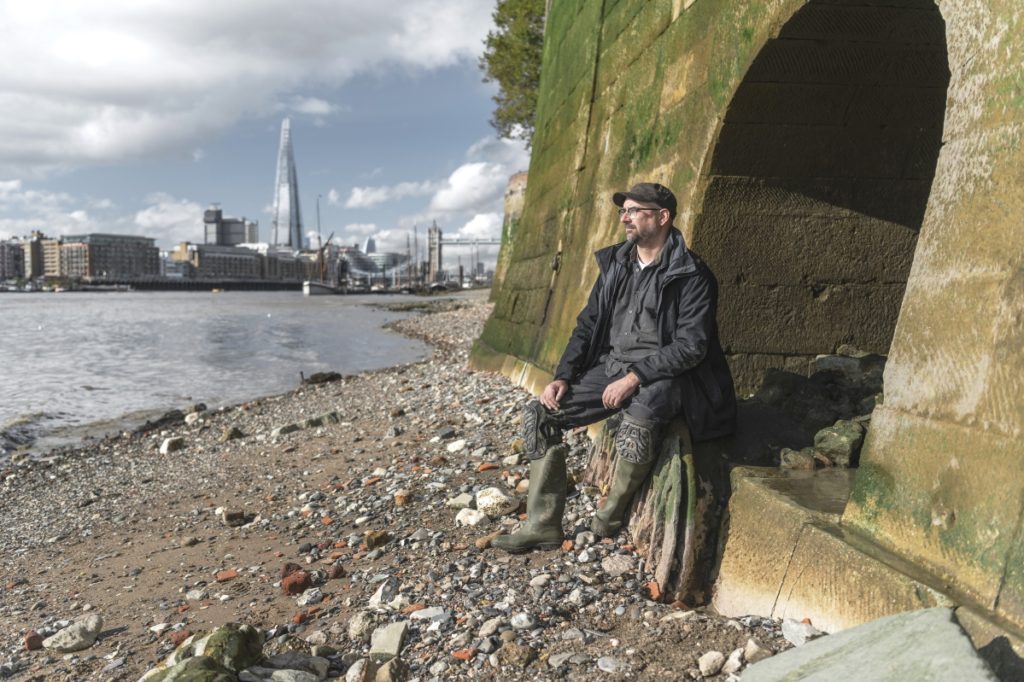
Mudlark’d author, Malcolm Russell on the foreshore of the River Thames, London.
©Thames & Hudson. —Matthew Williams-Ellis photo
Crisp morning air, the sound of the tide going out, a satisfying, crunchy squelch beneath rubber boots; this is the office of Malcolm Russell, author of Mudlark’d: Hidden Histories From The River Thames, which received publication in the United States in May. Russell is a historian and mudlark, part of an enthusiastic community that searches waterways worldwide for the physical history of their area. Compiled from the finds of 22 mudlarks, his richly illustrated book categorizes each artifact into a compendium of London’s inhabitants throughout history and how they related to these material remnants.
Mudlarking on the Thames was once far filthier and more dangerous. The poor of Eighteenth and Nineteenth Century London would scavenge the banks for valuable items or scrap materials to sell, and records survive of “mudlark” being listed as an occupation up to the early Twentieth Century. Today the foreshore is frequented by hobbyists and historians, many who are varying degrees of both. We corresponded with Russell about the intricacies of this practice and his own mudlarking experience.
Congratulations on the publication of your first book! How and when did you first find yourself on the banks of the Thames?
Thank you! As a teenager, I loved to excavate Victorian rubbish tips looking for old bottles. I later studied history and some archaeology at university. After working in New York City for a decade, I returned to London and was looking for a way of indulging my passion for the past. I’d seen people searching for artifacts on the Thames foreshore – the part of the riverbed exposed at low tide. I ventured down there, and on my first trip, found a fragment of a Seventeenth Century clay tobacco pipe poking out of the shingle. From that point on I was hooked on what’s known as mudlarking.
What are your favorite types of artifacts to find?
For centuries London was Britain’s busiest port and I’m especially interested in finding anything that illuminates its connections with the wider world. I’ve found coins from across the ancient Roman empire, pottery imported from Seventeenth Century China, glass beads sadly used to oil the wheels of the transatlantic slave trade, others traded for beaver pelts in North America and a pipe used to smoke opium made in Canton around the end of the Nineteenth Century.

Merchant’s signet ring, circa 1450-1550, found at Southwark by the author. © Thames & Hudson. —Matthew Williams-Ellis photo
How did you decide which finds to feature in your book?
The book uses objects found in the Thames to reveal the lives of forgotten Londoners and those passing through from around the world. The finds selected aren’t necessarily the most valuable, but little scraps of ordinary life that unlock these hidden histories. For instance, a battered die, handmade from bone, perhaps by a prisoner, led me to Eighteenth Century London’s prodigious gamblers. A pipe revealed the story of Edwardian stunt parachutists and a button, that of Britain’s first female chauffeur.
What is an unexpected benefit of mudlarking?
Mudlarking is the perfect antidote to the stresses of London life. The foreshore is this alternate world caught somewhere between the past and the present, water and land, the natural and the man-made. It’s a place to learn about the past but also a place to escape to.
Do you have a prized found object?
I’ve found thousands of objects, from Roman hairpins to medieval buckles to Georgian wig curlers and modern magical spells. One that stands out is a signet ring featuring the initials “RD” dating from around 1450 to 1550. It’s such a personal item and led me on a journey to identify who its potential owner might have been.
What advice would you give to aspiring mudlarkers?
If you want to try mudlarking in London you must first get a permit from the Port of London Authority and report any finds of significance to the Museum of London. And if you’re searching a tidal river, always know what time the tide turns and where your nearest exit is!
-Z.G. Burnett
Mudlark’d: Hidden Histories From The River Thames is available from the Princeton University Press. For information, 609-258-4900 or www.press.princeton.edu.
Editor’s note: Permits from the Port of London Authority are required to access the Thames Foreshore for any reason. Under the Treasure Act of 1996, gold and silver objects over 300 years old and possibly worth over £10,000 are classified as “Treasure,” and must be reported to The Portable Antiquities Scheme or the Thames Discovery Programme with the Museum of London. Discovered human remains of any apparent age must be reported to the Metropolitan Police.




